Freezing of Gait
Freezing of gait is characterized by hesitation before stepping forward or difficulties initiating walking. Some people with PD report feeling like their feet are glued to the floor.
This most common form of movement disorder affects 1 in 100 people. Medical science will ensure that you are not handicapped or disabled by it, read more…
Welcome to Jaslok Hospital, the epitome of excellence in healthcare, where we envision a world where Parkinson’s Disease is no longer a barrier to living life to the fullest. Our mission is to provide hope, healing, and a brighter future to all those affected by this condition. With our unparalleled expertise, cutting-edge technology, and compassionate care, we are dedicated to guiding you through every step of your journey toward hope, healing, and a better quality of life.
Parkinson’s Disease is a progressive Neurological disorder that affects millions of people worldwide.
Nerve cells in the substantia nigra produce the neurotransmitter dopamine and control body movement. When dopamine-producing neurons die, motor symptoms such as Tremors, slowness, stiffness, and balance problems occur.
Parkinson’s disease typically occurs in people over the age of 60, of whom about one percent are affected. Males are more often affected than females at a ratio of around 3:2 When it is seen in people before the age of 40, it is called young-onset PD.
The disease is named after a British physician, James Parkinson, who described it in “An Essay on the Shaking Palsy” in 1817. In Parkinson’s disease, nerve cells, also called neurons, in a region of the brain called the substantia nigra begin to malfunction or die, a process called neurodegeneration.
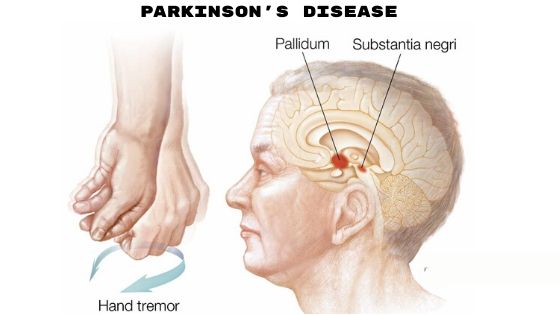
Parkinson’s Disease is a progressive neurological disorder that affects movement and is characterized by tremors, muscle stiffness, slow movements, and impaired balance. It occurs when nerve cells, or neurons, in a region of the brain known as the substantia nigra begin to die. These neurons create dopamine, a neurotransmitter that is essential for smooth, coordinated movement.
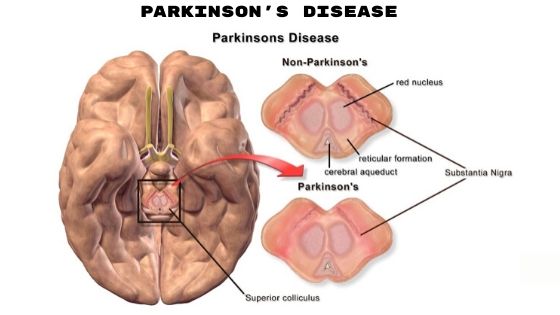
Dopamine is a neurotransmitter, one of those chemicals that is responsible for transmitting signals between the nerve cells (neurons) of the brain. Very few neurons actually make dopamine. Some, in a part of the brain called the substantia nigra, are the cells that die during Parkinson’s disease.
As Parkinson’s disease progresses and the brain has less and less dopamine, the symptoms of Parkinson’s disease become more apparent, and the patient develops tremors, severe movement issues, difficulty walking.
Discover the best exercises for reducing rigidity in Parkinson’s patients. Explore our blog post: Best Exercise for Reducing Rigidity for Parkinson’s People
Timely and accurate diagnosis are essential for effective management of Parkinson’s Disease. Even today, the diagnosis of Parkinson’s disease is based on neurological examination. According to one survey, the correct diagnosis is missed in almost 40% of the cases by routine neurologists and in 20% of cases by specialist neurologists. Our experience of more than 25 years in this field, makes us one of the best options for diagnosing this disease with high level of confidence and accuracy. Our state-of-the-art diagnostic facilities also enable us to perform a comprehensive evaluation. The following is a broad outline of various stages of diagnosis.
The doctor reviews the patient’s medical history and performs a thorough physical examination, focusing on symptoms, their progression, and any family history of neurological disorders.
Specific motor symptoms of Parkinson’s disease, such as tremors, slowness of movement, rigidity, and postural instability, are observed during the examination.
A trial of Parkinson’s medication, like levodopa, may be prescribed to observe if symptoms improve, supporting the suspicion of Parkinson’s disease if there is a positive response.
A detailed neurological assessment includes testing reflexes, muscle strength, coordination, and sensory function.
This nuclear medicine imaging technique assesses the dopamine system in the brain, helping differentiate Parkinson’s disease from other movement disorders.
While not mandatory, an MRI scan may be recommended to rule out other possible causes and symptoms, such as tumors or strokes.
Blood tests may be conducted to rule out other conditions with similar symptoms to Parkinson’s disease.
PET scans can measure brain activity and identify changes associated with Parkinson’s disease, providing valuable information in certain cases.
Movement Disorder Society-Sponsored Unified Parkinson’s Disease Rating Scale is a standardized assessment tool evaluates the severity of Parkinson’s symptoms and tracks their progression.
In some cases, genetic testing may be performed, especially with a family history of early-onset Parkinson’s disease or atypical symptom onset.
Dopamine Transporter Single Photon Emission Computed Tomography, Similar to DaTscan, this imaging technique assesses the dopamine system in the brain and aids in Parkinson’s disease diagnosis.
Rarely, a lumbar puncture may be performed to analyze cerebrospinal fluid for specific biomarkers associated with Parkinson’s disease.
Improve balance and mobility with effective exercises for people with Parkinson’s disease. Explore our blog post: Balance Exercises for People with Parkinson’s Disease
At Jaslok Hospital, we take immense pride in offering cutting-edge treatment options to our patients, constantly pushing the boundaries of medical advancements. Some of the primary treatments we provide include:
Medical science is ever-evolving, and we are at the forefront of incorporating innovative treatment approaches. From gene therapy to stem cell research, we explore emerging avenues to alleviate the burden of Parkinson’s Disease and improve the lives of those affected.
Enhance vocal strength and control with our recommended voice exercises for Parkinson’s disease. Explore our blog post: Voice Exercises for Parkinson’s Disease
Deep Brain Stimulation (DBS) is a revolutionary technique that involves implanting electrodes into specific brain regions to modulate abnormal neural activity. This procedure can significantly reduce tremors, stiffness, and other motor symptoms, enhancing the overall quality of life for patients.
Our skilled neurosurgeons perform specialized surgical interventions for Parkinson’s Disease, such as Pallidotomy and Thalamotomy. These procedures aim to target and alleviate specific symptoms by lesioning targeted brain areas safely and precisely.
When it comes to Parkinson’s Disease treatment in Mumbai, Jaslok Hospital stands apart for numerous reasons:
At Jaslok Hospital, our team of Parkinson’s Disease specialists brings unparalleled expertise and experience to the table. Their dedication to patient care and cutting-edge research ensures that you receive world-class treatment.
We invest in the latest medical technology, enabling precise diagnoses and effective treatments.
Each patient is unique, and we create tailor-made treatment plans that suit individual needs.
From diagnosis to post-treatment care, we cover every aspect of Parkinson’s Disease management.
Our focus is not just on curing the disease but also on improving the overall well-being of our patients.
Destruction of dopaminergic neuronal cells in the substantia nigra in the basal ganglia.
Degeneration of the dopaminergic nigrostriatal pathway.
Depletion of dopamine store Imbalance of excitatory (acetylcholine) and inhibiting (dopamine) neurotransmitters in the corpus striatum.
Impairment of extrapyramidal tracts controlling complex body movements.
Tremors rigidity Bradykinesia
Parkinson’s disease is caused by a loss of nerve cells in the part of the brain called the substantia nigra.
Nerve cells in this part of the brain are responsible for producing a chemical called dopamine.
Dopamine acts as a messenger between the parts of the brain and nervous system that help control and co-ordinate body movements.
If these nerve cells die or become damaged, the amount of dopamine in the brain is reduced.
This means the part of the brain controlling movement cannot work as well as normal, causing movements to become slow and abnormal.
The loss of nerve cells is a slow process. The symptoms of Parkinson’s disease usually only start to develop when around 80% of the nerve cells in the substantia nigra have been lost.
Some cases of Parkinson’s disease are hereditary, but this is rare.
This disease has been traced to different gene mutations. However, a strong family history of Parkinson’s disease can result in Young Onset Parkinson’s disease (YOPD) which occurs in people younger than 50 years of age.
It is believed that Parkinson’s disease is caused by genetic mutations. Only 15 percent of those who have Parkinson’s disease have a family history of it.
Research suggests that a combination of genetic and environmental factors (exposure to pesticides, herbicides, chemicals & other toxins) may cause Parkinson’s disease.
Parkinson’s disease (PD) is still primarily a clinical diagnosis, and there are no definitive laboratory tests or brain scans to confirm it. Most of these tests are conducted to rule out other diseases that mimic PD.
Resting tremors are the most common form of tremors associated with Parkinson’s disease. They occur when the muscles are relaxed and still, such as when the patient is lying in a bed or when their hands are resting on their lap. It is one of the noticeable prime symptoms of Parkinson’s disease.
Resting tremors can also be ‘pill-rolling’ tremors, due to the actions of the tremor resembling the motion of rolling a small pill between the thumb and index finger.

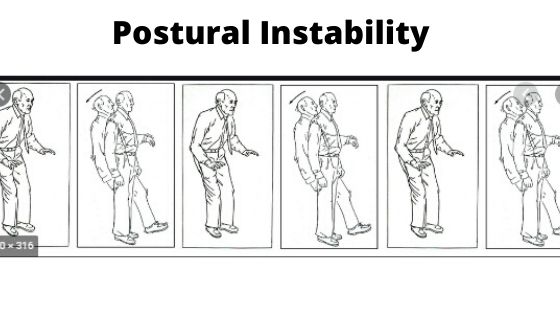
A balancing issue is one of the primary motor symptoms of Parkinson’s disease (PD) that usually emerges in the late stages of the disease. Postural instability appears as tendency to be unstable when standing, as PD affects the reflexes that are necessary for maintaining an upright position.
Parkinson’s patients often experience a sudden change in their handwriting, a phenomenon medically known as “Micrographia.” Individuals with Parkinson’s disease may start with normal handwriting, but gradually, their writing becomes smaller and more cramped. Observe how the handwriting progressively shrinks, even during signatures. The first letter, ‘R,’ is large, while the last letter, ‘A,’ is barely legible. This change also becomes typical during the ON phase of medication.

Rigidity or stiffness is one of the primary motor symptoms of Parkinson’s disease. Parkinson’s patients usually experience uncomfortable or painful motions while performing their daily activities. For example, they may feel their feet seem to be stuck on the floor, have difficulty moving from their bed, or have difficulty arising from the chair, which can result in painful muscle cramps.
The slowness of movement is one of the main symptoms of Parkinson’s. The general effect of bradykinesia is that it takes more time and effort to complete daily tasks, which can result in fatigue.
Also known as “Hyposmia”, people with PD experience a reduced sense of smell. If you seem to have trouble smelling foods like fruits, pickles, etc., then it’s often an early sign of Parkinson’s.


The PD patients experience trouble falling asleep and nightmares regularly. They might also face difficulties such as talking or yelling out while asleep, vivid dreaming, leg movements, jerking, cramping, difficulty turning over in bed, waking up to go to the bathroom, and excessive daytime sleepiness.
Shuffling gait appears as if the person is dragging their feet as they walk. Steps may also be shorter in stride (length of the step) in a shuffling gait.
Freezing of gait is characterized by hesitation before stepping forward or difficulties initiating walking. Some people with PD report feeling like their feet are glued to the floor.
A quickening and shortening of normal strides characterize festinating gait. While the steps are quicker, the stride is shorter, causing this to be a very inefficient gait, which can be frustrating and tiring for the person experiencing it
Parkinson’s often affects the natural facial expressions of the PD patients, such as a serious look or depressed facial look even though the discussion is normal. Their face seems expressionless and they blink less often.
The patient seems to be stooping or hunching over when standing and not standing up straight.

People with Parkinson’s Disease might slur words, mumble, or trail off at the end of a sentence. Most people talk softly, monotonously, and even stutter or stammer. This condition is also known as Hypophonia.
In an “on” period when the patient takes doses of medicines like levodopa regularly, they may feel energetic and can easily perform regular activities. Patients take maximum advantage of this period to complete their activities.
“Off” periods are times when Parkinson’s disease (PD) medication, namely levodopa, is not working optimally. As a result, symptoms return. These can include both motor symptoms, such as tremor and rigidity, and non-motor symptoms, such as anxiety.
In Off period the most common complaint severe body pain, painful spasm, neck and shoulders pain due to sever stiffness of the muscles.
This usually occurs due to the side effect of long-term levodopa treatment. The symptoms vary from person to person.
Dyskinesia is an involuntary movement that can affect an arm or leg or the entire body. It is often fluid and dance-like, but it may also cause rapid jerking or slow and extended muscle spasms. Dyskinesia can also cause severe weight loss.
The “on-off” phenomenon in Parkinson’s disease (PD) refers to a switch between mobility and immobility in levodopa-treated patients, which occurs as an end-of-dose or “wearing-off” worsening of motor function or, much less commonly, as sudden and unpredictable motor fluctuations.
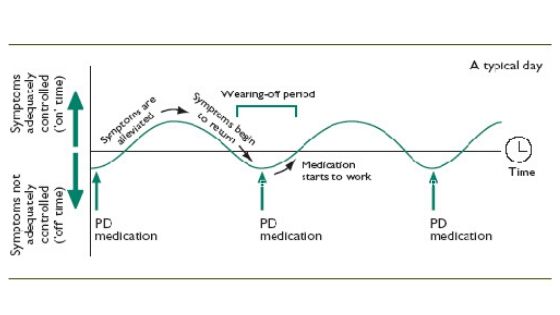
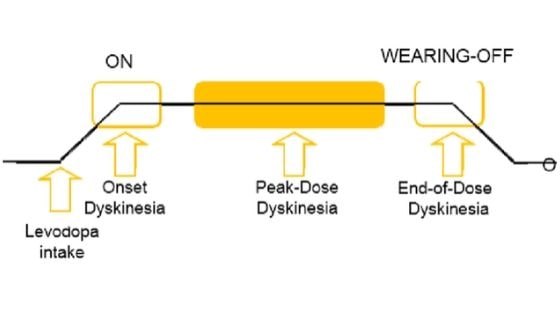
The term “Advanced Parkinson’s Disease” refers to when the symptoms are complex and are adversely affecting the day-to-day life of PD patients.
Difficulty swallowing, called dysphagia, can happen at any stage of Parkinson’s disease. Signs and symptoms can range from mild to severe, including difficulty swallowing certain foods or liquids, coughing or throat clearing during or after eating/drinking, and feeling as if food is getting stuck.
As the disease progresses, swallowing can become severely compromised, and food/liquid can get into the lungs, causing aspiration pneumonia.


“Cognitive impairment” is characterized by predominant executive function deficits, difficulty finding words and learning, recalling information, and slow thinking. Many people with PD face difficulty in focusing on a task or managing household chores.
Patients with Parkinson’s often develop non-motor symptoms, such as Depression, anxiety, anger, and apathy, which affect their quality of life. Depression is one of the most common symptoms that can be effectively managed with medication, and hallucinations may occur as a side effect of long-term dopamine treatment.

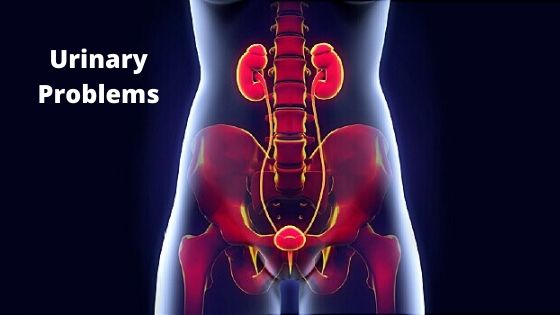
Urinary symptoms are frequently present in patients affected by Parkinson’s disease (PD). Symptoms such as urgency, frequency, nocturia, and urge incontinence significantly impact the patient’s quality of life.
In some people with Parkinson’s disease, constipation may occur due to the improper functioning of the autonomic nervous system. The autonomic nervous system is responsible for regulating smooth muscle activity.
If this system is not working correctly, the intestinal tract may operate slowly, causing constipation.
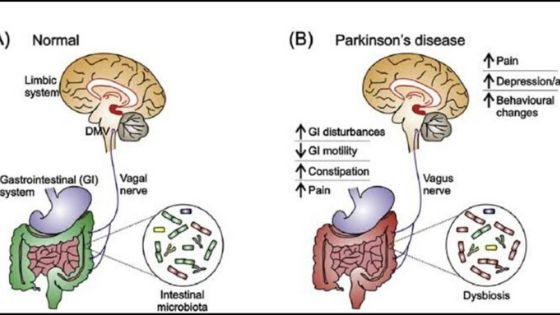

Erectile dysfunction is a common non-motor disorder in Parkinson’s disease (PD). In contrast to motor disorder, sexual dysfunction is often not responsive to levodopa treatment.
Orthostatic hypotension is a severe drop in blood pressure that occurs when a person stands up from sitting or lying down. It can occur within three minutes of standing up and may cause dizziness or a loss of consciousness, causing the person to faint or pass out.
Orthostatic hypotension can be dangerous, as it can put the person at serious risk of falls and injury.
Orthostatic hypotension is common in elderly people, and it occurs frequently in people with Parkinson’s disease (PD).

Advanced aging- Young adults rarely experience Parkinson’s disease. It usually demonstrates itself in the middle to late years of life. The risk continues to increase the older one gets. Investigators assume that people with Parkinson’s have neural damage from genetic or ecological factors that get worse as they age. People usually develop the disease around age 60 or older.
Heredity- Having a close relative with Parkinson’s Disease increases the chances that you’ll develop the disease. However, your risks are still small unless you have many relatives in your family with Parkinson’s disease.
Sex- Men are more likely to get Parkinson’s than women. Potential reasons for this may be that males have larger exposure to other risk factors such as toxin exposure or head trauma. It has been hypothesized that oestrogen may have neuro-protective effects OR in the case of hereditary predisposition, a gene predisposing someone to Parkinson’s may be linked to the X chromosome.

The selection of medication and their dosage is tailored to each individual patient. In deciding the treatment, the physician considers factors such as the severity of symptoms, the patient’s age, and the presence of other medical conditions.
No two patients will respond identically to any particular drug, so this process involves experimentation with different drugs, persistence, and patience. As the disease progresses, drug dosages may have to be altered and a combination of drugs can be given.
A combination of Levodopa and Carbidopa is the mainstay of treatment in Parkinson’s disease. Levodopa is rapidly converted into dopamine, by the enzyme dopa decarboxylase, which is present in the central and peripheral nervous system, however much of the levodopa is metabolized before it reaches the brain.

Carbidopa blocks the peripheral metabolism of levodopa i.e. in the liver and increases the amount of levodopa that reaches the brain.
Levodopa is most effective in treating bradykinesia and rigidity, less effective in reducing tremor, and very less effective in relieving problems with balance.
Side effects include nausea, low blood pressure (hypotension), and abnormal movement’s i.e. dyskinesias.
Slow dosage adjustment and taking medication with food can reduce these effects. Depression, confusion, and visual hallucinations are the side effects that may occur with these medications, especially in the elderly.
Dopamine Agonists mimic dopamine’s function in the brain. They are used primarily as adjuncts to levodopa/carbidopa therapy.
But in some cases, these drugs are used as monotherapy, but generally less effective in controlling symptoms. Side effects are similar to those produced by levodopa and include nausea, sleepiness, dizziness, and hallucinations.
It is an antiviral drug that has dopamine agonist properties. It increases the release of dopamine and is used to treat early-stage Parkinson’s disease.
It can be used either alone, with an anticholinergic drug, or with Levodopa. It is effective in reducing dyskinesias caused by Levodopa. Side effects of amantadine include mottling of the skin, edema, confusion, blurred vision, insomnia, anxiety, etc.
Monoamine oxidase B (MAO-B) oxidizes dopamine. Rasagiline and Selegiline inhibit MAO-B and increase the amount of available dopamine in the brain.
MAO-B inhibitors boost up the effects of Levodopa. Side effects include nausea, dizziness, abdominal pain, confusion, hallucinations, and dry mouth.
MAO-B inhibitors are contraindicated in patients taking tricyclic antidepressants, SSRIs, or Meperidine and other opiates. Patients taking MAO-B inhibitors are advised to follow physician’s recommendations regarding a number of dietary precautions.
It reduces the relative overactivity of the neurotransmitter acetylcholine to balance the diminished dopamine activity.
This class of drugs is most effective in the control of tremors and is used as adjuncts to Levodopa.
Side effects associated with anticholinergic drugs are dry mouth, blurred vision, constipation, and urinary retention. In higher doses, these medications may also impair memory.
Inhibits the COMT enzyme, which breaks down dopamine after it is released in the brain and augments the effect of levodopa. These drugs are effective only when they used with Levodopa. COMT inhibitors include Entacapone and Tolcapone.
The side effects of these medications include vivid dreams, visual hallucinations, nausea, sleep disturbances, daytime drowsiness, and dyskinesias.
Exercise and diet, as well as lifestyle changes, typically are the first steps in the treatment of constipation.
A high-fiber diet (fruits & green leafy vegetables) and intake of plenty of fluids, small portions of meals at regular intervals, and proper chewing of food is recommended. Laxatives and stool softeners are also recommended.
Know more about the proper diet for Parkinson’s disease
To maintain overall good health most people living with Parkinson’s disease should eat a variety of whole grains, vegetables, fruits, milk and dairy products, and normal protein food.
Also consider including nuts, olive oil, fish, and eggs to your diet, for their beneficial fats.
Yoga is one of the most beneficial complementary therapies for Parkinson’s disease (PD), helping to increase flexibility; improve posture; loosen tight, painful muscles; build (or rebuild) confidence; and, through these benefits, enhance the quality of life.
Know more about- Best Exercises for People With Parkinson’s Disease
Dance appears to be very helpful in improving gait and balance in Parkinson’s patients.
It also can provide social stimulation and support, which can be helpful in reducing depression and improving the quality of life. Plus, dance stimulates cognitive functioning, an area that PD patients often struggle with.
Speech Therapy can help people with Parkinson’s disease maintain as many communication skills as possible.
They also teach techniques that conserve energy, including non-verbal communication skills. Speech Therapy also improves swallowing problems.
Know more about Best Tips to Improve Voice Quality & Voice Exercises for Parkinson’s Disease
This therapy helps patients to participate in the activities of everyday life by working with them to improve their ability to engage in tasks they want to, need to, or are expected to do.
The key pathology in Parkinson’s Disease (PD) is α-synuclein accumulation. Large α-synuclein aggregates form round lamellate eosinophilic cytoplasmic inclusions, Lewy bodies (LBs) in the neuronal body. α-synuclein is toxic. Its accumulation impairs the functions of the cell. The core pathology of PD affects the dopamine-producing neurons of the substantia Nigra (SN). In advanced PD, loss of pigmented neurons results in gross depigmentation of the SN.
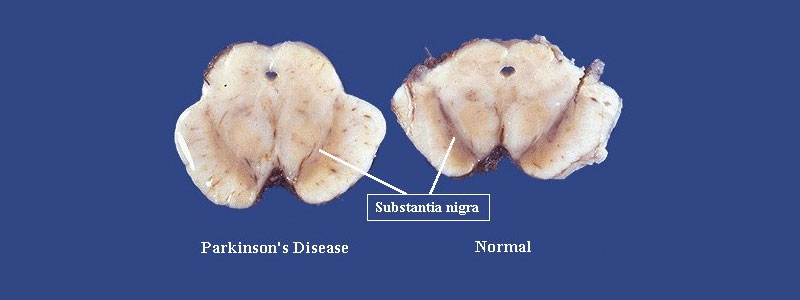
The triad of rigidity, bradykinesia and tremor at rest correlates with degeneration of the dopaminergic nigrostriatal pathway and dopamine depletion in the striatum. α-synuclein deposits and LBs are also present in the cerebral cortex, limbic system and in many extra-nigral neuronal groups. This is the underlying pathology for PD.
While there’s no food or combination of foods proven to help in Parkinson’s Disease (PD), some foods may help ease some of the symptoms. For example, eating foods high in fiber and drinking an adequate amount of fluids can help prevent constipation that is common in PD. A balanced diet also provides nutrients, such as omega-3 fatty acids, that may be beneficial for people with PD.
Exercising may increase your muscle strength, flexibility and balance. Exercise can also improve your well-being and reduce depression or anxiety.
Yoga can help to improve your posture and balance. The trunk exercises can help to prevent excessive stooping and make the body more agile. Gait training by an expert can also assist in improving balance and avoiding falls.
Some of the suggestions that may help:
Meditation along with yoga can improve the sense of well being, concentration and memory function. It also involves various forms of breathing exercises beneficial to the patient.
In the later stages of the disease, you may fall more easily. The following suggestions may help:
Daily living activities — such as dressing, eating, bathing and writing — can be difficult for people with PD. An occupational therapist can show you techniques that make daily life easier.
Frequent falls, gait disturbances etc. can lead to increased morbidity in PD patients. Occupational therapists can help by providing various physical aids and solutions for the same. This include installing “grab bars” in the house, a chair lift, handrails in the bathroom etc. This reduces the dependence of the patient on the caretaker, making him more independent.
A speech therapist can help people with the disease improve swallowing and can recommend changes in diet for patients with advanced problems swallowing. Speech therapists can also help patients with muffled or slurred speech, a hoarse voice and other speech problems speak more clearly and comfortably.
People with PD do not need to eat a specific diet, but getting enough calories and nutrients will help maintain bone, muscle and strength. People having problems with weight loss or poor appetite or eating may benefit from seeing a dietician. Certain changes in diet can also help some people. For example: protein in a meal can reduce the effect of levodopa-carbidopa in some patients. Drinking enough water and eating a high-fiber diet—including whole grains, fruits and vegetables—can help ease constipation.
Music or art therapy may help you to relax. Music therapy helps some people with Parkinson’s disease to improve their walking and speech. Participating in artistic activities, such as painting or ceramics, may help in improving your mood and help you relax. “Tai Chi”, an ancient form of Chinese exercise, slow, flowing motions that may improve flexibility, balance and muscle strength. Tai Chi may also prevent falls.
As the disease progresses there may be a role for a qualified physiotherapist to improve the various activities of daily living. Physical therapists can teach people with Parkinson’s how to strengthen their muscles, expand their range of motion, and improve their balance and can help in managing symptoms like tremor, rigidity and freezing. Physical therapists can also teach people with the disease how to walk more safely and how to use a cane or walker when necessary. This can help prevent falls that become more common as the disease progresses, and may cause serious injury.